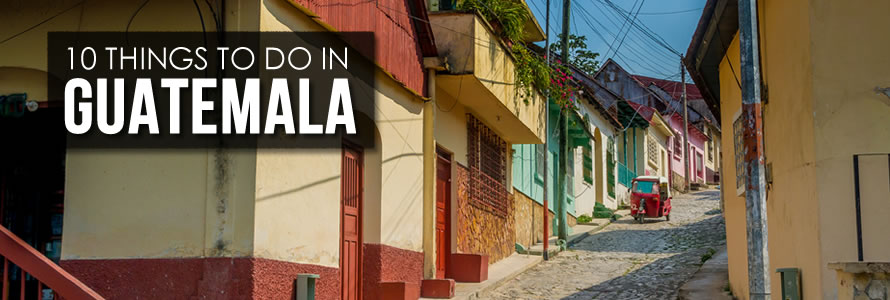From caving by candlelight to sitting atop Mayan pyramids to watch the sunrise, Guatemala offers its visitors all of the things which most often feature on travellers’ wish-lists along with some very special experiences which you won’t find elsewhere. It is all here – wildlife, natural splendour, sacred places, fiery volcanoes, thrilling adventure, peaceful tranquillity and a fascinating blend of Spanish colonial and traditional Mayan culture and throwbacks. Here are 10 of the best things to do in Guatemala, in no particular order.
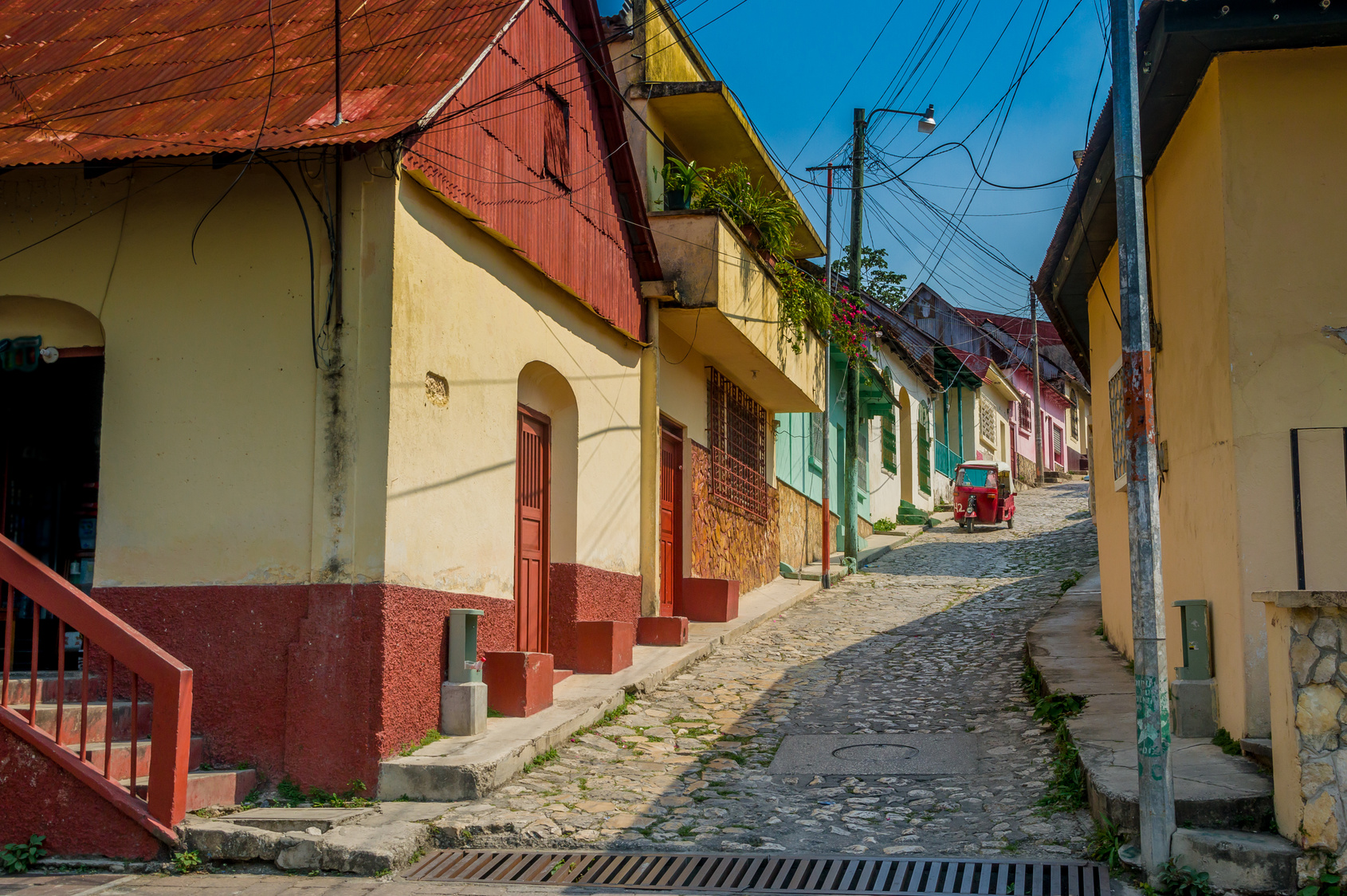
1) Visit Sunglass-sporting Saint Maximon (if you can find him) at Lake Atitlan
Dotted around its perimeter by Mayan villages as old as time and as charming as could be wished for, Lago de Atitlan is Central America’s deepest lake. This place has enormous spiritual significance for its indigenous residents and as somewhere which can only be described as simply lovely it is much visited by travellers and tourists.
You can pick where to base yourself depending on what appeals most. Perhaps tiny San Marcos – a strong magnet for the spiritually inclined or those looking to explore their inner hippy; a perfect place for the yoga passionate, fans of meditation or simply the spot to visit to get your chakras back in alignment or stock up on herbal medicines. Bustling San Pedro on the other hand is an entrancing labyrinth of climbing alleys and lanes where every door may (or may not) lead to some secret garden, restaurant or smoothie bar with spectacular views of the lake. Or perhaps you would prefer minuscule and almost vertically built Santa Cruz?
While several of the villages and the main town of Panajachel are linked by a very regular lake ferry service there are other communities which can only be reached on foot or by renting a kayak if you prefer to set your own lake tour itinerary and schedule. Wherever you decide to stay or explore make sure the little village of Santiago is in there somewhere because this is where you will find the downright bizarre and ever-moving shrine of Maximon. Part Mayan deity and part Catholic saint, sunglass-wearing, cigarette-smoking, alcohol-guzzling Maximon houses himself in a shrine the like of which you will not have seen before or are likely to see again. Every year a different family acts as host for Maximon’s shrine so we can’t tell you where he’ll be – you’ll have to hunt him down for yourself but that is all part of the adventure.
2) Learn Spanish at Bargain Basement Prices
The experience of travelling around any country becomes wonderfully enhanced if you can get to grips with the local lingo; doors open up and even a smattering of linguistic mastery will lead you to adventures you almost certainly would never have had otherwise.
Guatemala is one of the cheapest places in the world where you can grab yourself some Spanish lessons whether you are looking for a class set-up or some intensive one-to-one, spanning few hours or several months. A super popular place to learn is Quetzaltenango – otherwise shortened to the rather more pronounceable name of Xela (pronounced she-la). This part Colonial Spanish, part German Gothic town, which also acts as a base for hikes up the impressive and massive Tajululco volcano, has so many schools and individuals offering Spanish lessons prices are rock bottom.
If you prefer to wrestle with the finer points of a foreign language surrounded by beautiful nature, Lago de Atitlan is another popular spot with several long established schools to choose from. The major bonus of learning here is that the indigenous locals of Atitlan also speak Spanish as a second language which makes conversing a little easier than with native speakers.
3) Idyllic Swimming at Stunning Semuc Champey – Where the River Hides Under the Stones
If you are into fairytale-like settings and magical places you will need to get yourself to Semuc Champey in Alta Verapaz. The isolation of this spot makes getting there seem very intrepid and although most travellers base themselves in the nearby village of Lanquin there are hostels at Semuc Champey itself if you want to be right where the action is. The ‘action’ is a 300 metre limestone ‘bridge’ under which flows the Cahabon River, carving out a series of caves as it goes. The top of this natural geological wonder is a series of stepped turquoise pools which each feed the one below it and make for some of the most idyllic swimming you are likely to find anywhere. Cool down in waters in hues of the impossibly beautiful variety as tiny fish nibble at your toes and lush tropical greenery crowds in from every side.
Caving is a popular activity here (usually with faces daubed with war-paint for some inexplicable reason) where one of the greatest challenges (and there are several) is keeping your candle alight as you attempt to swim across underground pools. Tubing on the river is also possible as well as hiking up to a view point above the pools.
4) The Sound of Dinosaurs at Dawn & Guatemala’s Most Impressive Mayan Ruins – Tikal
Although Guatemala has just short of 20 Mayan ruin sites none are as famous or more visited than the UNESCO World Heritage listed Tikal. Dating from as far back as 400 BC, Tikal was about as large and important as it got for the Mayans but when the Mayan civilisation declined around 900 AD Tikal was abandoned and consequently swallowed up by the jungle. This remote jungle setting – where many buildings still lie buried and waiting to be restored – is one of the things which makes Tikal so popular and atmospheric. Another factor is that the site is so scattered and vast that no matter how many bus-loads of tourists descend on it it never feels overrun.
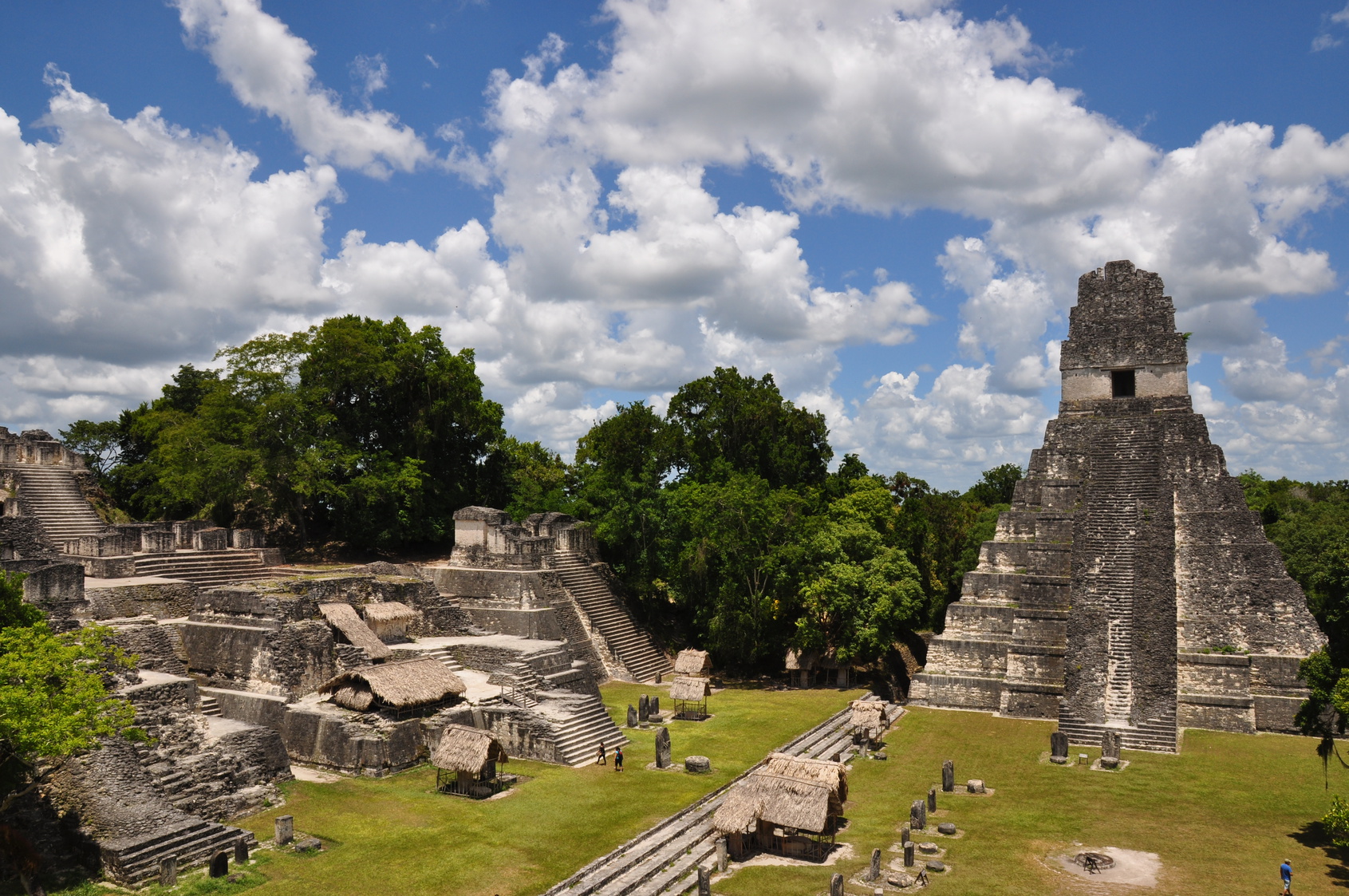
Many of the pyramids and structures can be climbed, toucans flying over the ruins are a common sight and you can even watch archaeologists at work if you time your visit right.
For an extra special Tikal experience book onto a tour which will have you sitting atop a pyramid as the sun rises. The sight of Mayan buildings poking up through the jungle canopy and the mists which cloak them in the early morning is truly spectacular. Factor in the sounds of the jungle waking up and the dinosaur-like roars of the howler monkeys (actually used to represent the Tyrannosaurus rex roars in Jurassic Park) and you have probably just bagged yourself a travel memory unlikely to fade for a long time.
5) Fill Your Photo Gallery With the Candy Colours of the Shrines At Chichicastenango Cemetery
It’s not so often in life that cemeteries put you in mind of a multicoloured candy store but the beautiful and decidedly different hillside cemetery just outside of Chichicastenango proves graveyards don’t need to be all sombre and monotone.
The candy pinks, blues and yellows dotted about with more vibrant shades of scarlet or vivid green are not accidental either. Each colour represents something – be it turquoise to symbolise protection of a mother’s grave, white for purity, yellow to pay homage to sun deities or simply a colour that the deceased favoured in life.
Despite its proximity to the tourist-recognised Chichicastenango, this Mayan cemetery filled with mausoleums and towering crosses is little visited by tourists but those who do find their way here are often positively affected by its air of celebration for the afterlife.
If you happen to be in town around the Day of the Dead (end of October/beginning of November) be sure to get yourself to this cemetery to drink in the spectacle of rows of candles along with a spot of ancestor worship involving alcohol and occasionally sacrificial offerings of chickens.
6) Try Some Natural Hot Spring Water Healing, Courtesy of a Volcano or Two
Guatemala is a land of volcanoes – almost 30 to be more precise and although the majority of them are dormant or extinct 3 are currently very much active. The same ever-moving underground forces which are responsible for such activity also make the country something of a hotspot (no pun intended) for natural thermal pools, hot-springs and saunas which come in every variety from large, flashy and commercial to rough, ready and tucked away in secret locations.
Of the first type are the hot pools known as Las Fuentes Georginas, 8 km from Zunil and 19 km from Quetzaltenango, in an area overlooked by both Zunil and Santo Tomas volcanoes. Originally discovered in 1902, there is a choice of 4 sulphur-spring fed natural mineral pools here which will help work out some of the kinks from all the adventuring you have been doing.
Before or after you hot pool experience you can add ‘exploring the rainforest’ to your what-I-have-done-today’ list because Fuentes Georginas also acts as the entrance for both forest reserve and the pathway to Zunil volcano.
If you prefer your thermal experiences a little less developed you could check out another Quetzaltenango region choice – Los Vahos. Overlooking Xela itself and tucked into the hills at the foot of Cerro Quemado volcano can be found these rustic steam-mineral baths which offer a natural sauna courtesy of the volcanic vent over which they are located. Opt for the first floor tiled choices or head down a level to get a little more intimate with the volcano in a few dark and somewhat more basic rooms instead.
Another option is the very large spa complex known as Kawilal Hot Springs a few kilometres out of Antigua. Otherwise, you’ll need to get chatting to some locals to discover secret spots shared only with the privileged few.
7) Walk With the Spanish Colonials in the Historic Streets of Antigua
Once the capital of Guatemala until a devastating earthquake all but destroyed it in 1773, Antigua is today the jewel in the country’s crown of its colonial past. Present day Antigua has something of a sleepy air despite being ringed about by volcanoes both sleeping and wide awake. These include the regularly hiked Pacaya, Acatenango, the very active Fuego and De Agua. This latter must be one of the most photographed volcanoes in the country because it lines up perfectly to form a backdrop through the city’s stunning Santa Catalina Arch making for a shot which surely must have been delivered by the gods of perfect photographs. Otherwise, these volcanoes can often be seen belching out smoke and ash from elevated points around the city. For a truly panoramic view of it all take a stroll (or cheat and take a taxi) to the top of the Hill of the Cross.
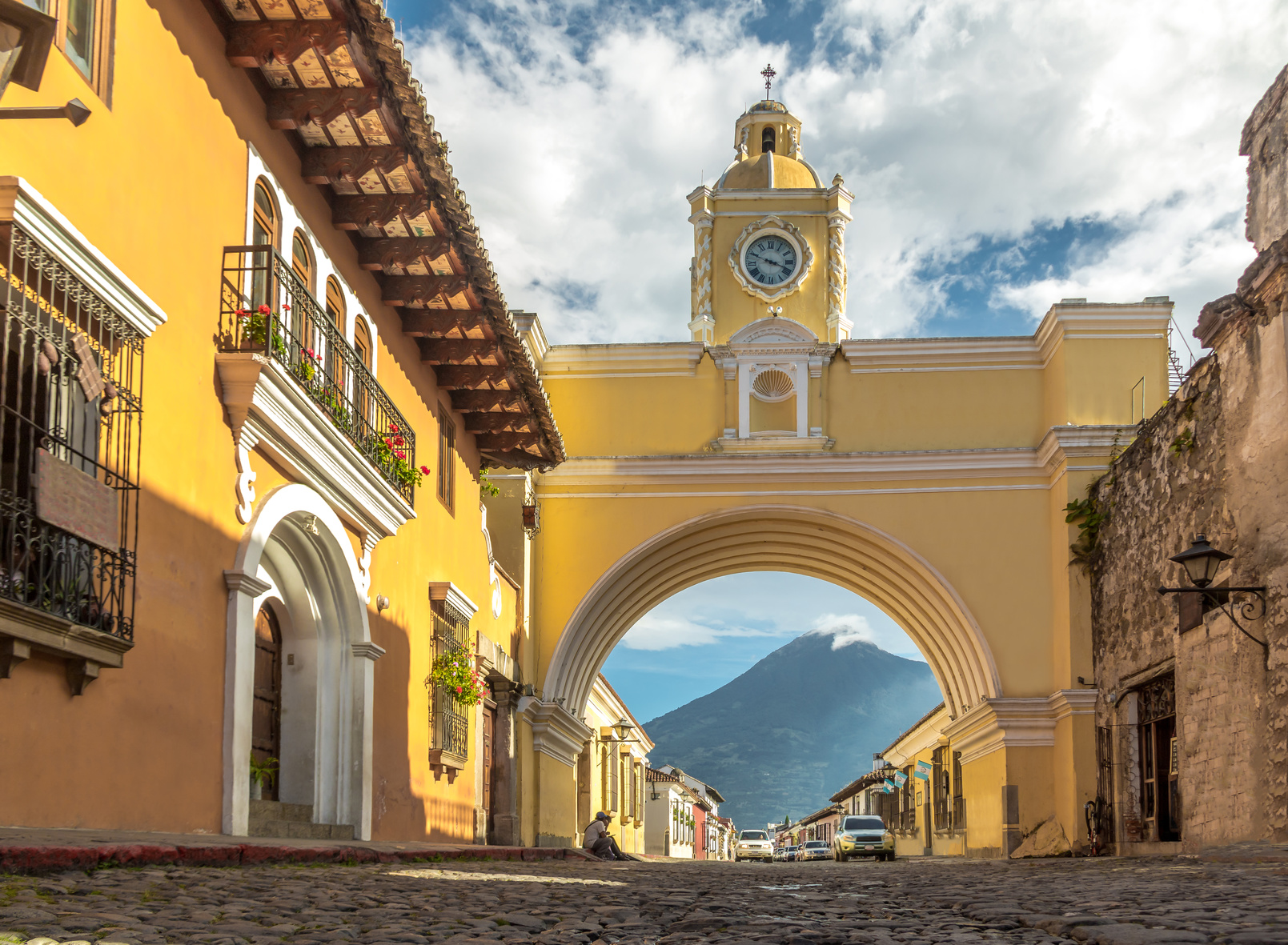
World Heritage-listed Antigua has mostly found its popularity on the tourist map due to its stunning and well preserved Spanish colonial architecture. Palaces, churches, convents, cathedrals, fountains, statues and other historical buildings can be found at every turn. The very centre of this compact and easily navigable on foot city is marked by the main plaza complete with plenty of benches covered by shade-giving trees for a spot of people watching.
8) Be Charmed by the Tranquil Island Oasis of Flores
For many Flores is nothing more than the most convenient access point to UNESCO-listed Tikal but seeing it just as that is selling both yourself and this lovely tranquil oasis short. Situated on the edge of Lago Peten Itza, both the communities of Santa Elena and San Benito are often named under the Flores umbrella but in truth Flores is actually just the lovely little island which joins the mainland by way of a causeway.
Geographically speaking there isn’t much to Flores – it can be covered from end to end or even all the way round with a relatively short stroll but its entirety is packed with colourful colonial houses set along cobbled streets while also boasting a church, a plaza, a museum and several cafés and restaurants. Simply put it oozes charm at every twist and turn. Flores is about kicking back for a while, soaking up the peace and haggling with a boat owner to take you for a leisurely tour of the lake. If you prefer to explore in your own time you can rent a canoe instead.
9) Soak Up Some Caribbean Vibes in the Beautiful Rio Dulce & Livingstone
While certain stereotypical images tend to spring to mind when picturing Latin American countries, totally tropical Caribbean vibes doesn’t tend to be one of them. However, all of the Central and to a lesser degree the South American countries which claim coast along the Caribbean side have some element of this and it tends to offer an astonishingly different experience to the rest of the country with regard to cuisine, culture, music, arts and even language. Guatemala is no exception and if you don’t make your way east here then you haven’t experienced all the incredible diversity the country offers.
Head this way and you will encounter the country’s largest lake – Lago Izabel – which is fed by the Rio Dulce (Sweet River). This area’s town is also known as Rio Dulce and has an anti-pirate Spanish colonial fort – Castillo De San Felipe – as well as the Quirigua Mayan ruin site, the Finca Paraiso hot springs waterfall nearby and the entire stunning gem known as Rio Dulce National Park on your doorstep. From here hop on-board one of the daily boats which will take you all the way downriver, passing as you go through rainforest, manatee populated waters and a spectacular sheer-sided gorge making for a ride of the memorable kind. Your destination is Livingstone, a tiny coastal town only accessible by water and heavily populated by the Garifuna people – descendants of African slaves. Latino living seamlessly combined with Caribbean culture makes for a colourful and fascinating mix which you will find nowhere else in the entire country.
10) Fill Your Backpack with Handcrafted Colour at Chichicastenango Market
Not everyone who comes to Chichi market falls in love. What some describe as wonderfully chaotic and a colour-filled assault on the senses others describe as smelly and noisy. There is no doubt that if you hate crowds, jostling for space on narrow pathways and being among a lively thrum of people you should perhaps avoid it. Otherwise a visit is a must to this handicraft-cum-everything else market which is located in an indigenous village perched on a mountain crest about 127 km north-west of Guatemala City.
Taking place only on Thursdays and Sundays, this market acts as a focal point for the Mayan folk from surrounding hillsides and communities who come loaded down with their hand-crafted wares to sell alongside home-grown food produce, animals, flowers and a plethora of random items both essential and useless. Part of the draw for the tourists here is seeing the market ladies sporting their traditional dress of the K’iche’ or Quiche Mayans.
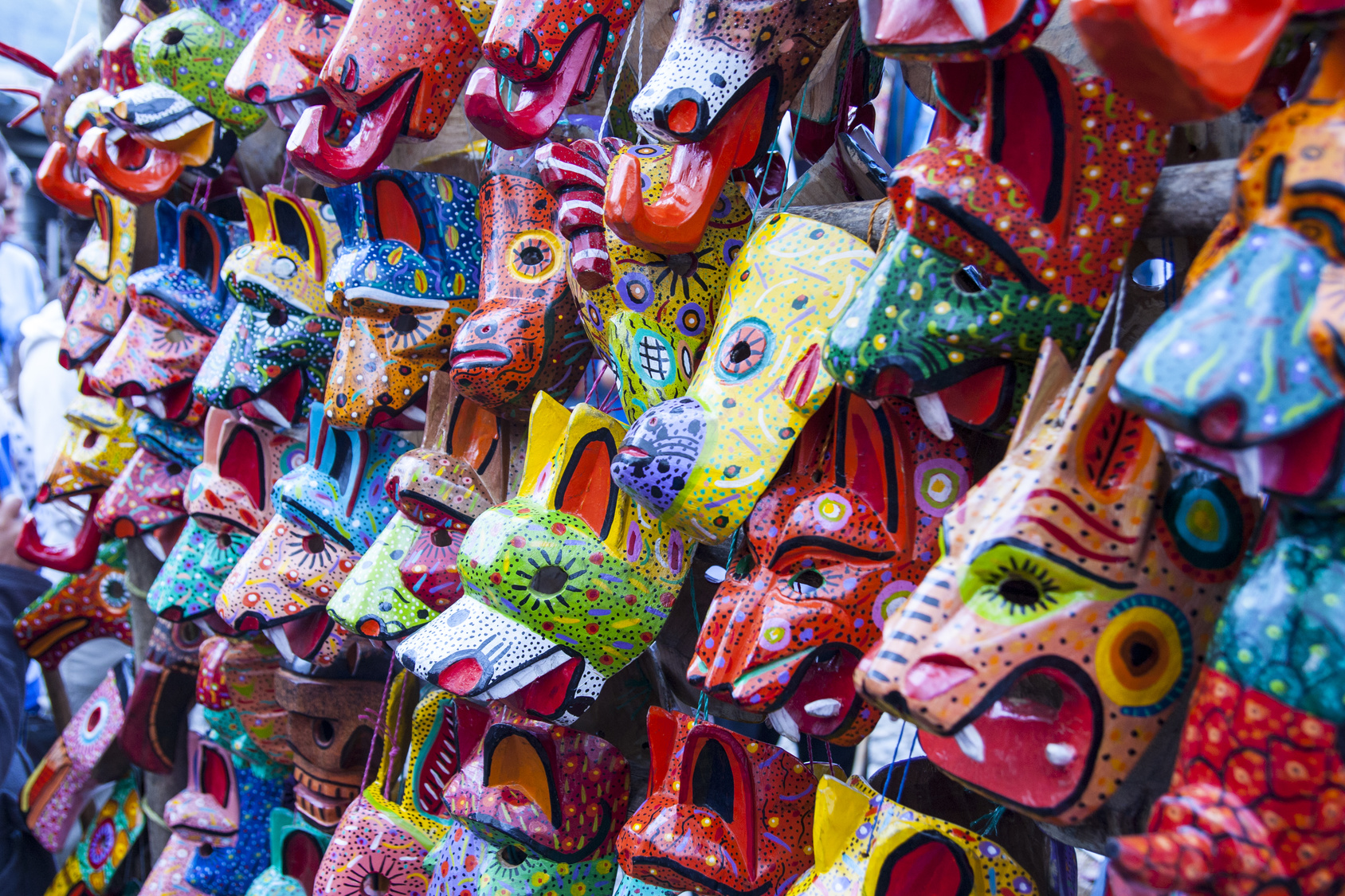
It is often bandied about that this is the largest handicraft market in the world which may be something of a questionable claim but it is large and often features on ‘best of’ lists such as Frommers which describes it as ‘one of Latin America’s most colourful and traditional markets’.
One of the reasons the market is so often described as colourful is thanks to the wealth of stunningly beautiful hand-made textiles you can find here which includes bags, clothing, rugs, throws, table linen and bedding.
Other commonly sold goods include carved wooden masks, incense, basket-ware, pottery, spices and condiments and so much more…from medicinal plants to machetes and carved boxes to candles. One of the most commonly heard whines of those in the Chichi market detractors camp tends to be ‘I can buy souvenirs cheaper elsewhere’ but this isn’t really the point. Many of the hand-crafted goods here are not intended as cheap trinkets but offered as truly unique and quality items. As you would expect from any self-respecting market the world over, food sellers are in plentiful supply for refuelling and refreshing in between hunting down treasure.

